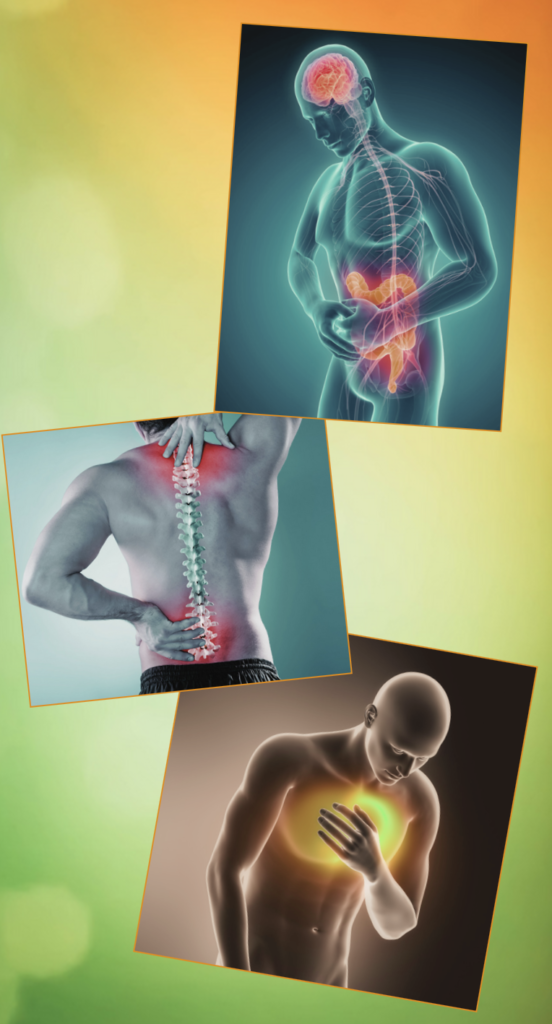
Your Autonomic Nervous System
An explanation from Dr. Lori Parker
Please note that I, Lori A. Parker, am not a medical doctor. Nor do I have any formal psychological training. I am a Somatic Experiencing Practitioner®. Somatic Experiencing® is a method developed by Dr. Peter Levine which helps restore balance to the Autonomic Nervous System (the stress-control mechanism in our bodies). Dr. Levine holds doctoral degrees in both Medical Biophysics and Psychology.
The Autonomic Nervous System regulates your organ function and internal homeostasis. It is also the stress control mechanism in your body. For both of these reasons, you would not want this part of your nervous system to be malfunctioning. One need only to look at the picture below to see that a malfunctioning ANS could lead to a wide variety of organ-related symptoms.

Your Autonomic Nervous System is divided into two separate divisions. One is the Sympathetic Nervous System (SNS) and the other is the Parasympathetic Nervous System (PSNS). There are also two phases to the stress response involving the SNS and PSNS. Ideally, the charging (sympathetic) phase is quickly followed by a calming (parasympathetic) phase of equal magnitude. In such cases, the cycle completes itself, homeostasis (internal equilibrium) is reestablished, and the stress can be deemed resolved. The following example can serve to clarify how this system works.
For a moment, imagine that you step off a curb and almost get hit by a semi-truck. You instinctively and quickly jump back onto the curb and – after the fact – you think, “Oh my god, I could have been killed.” You notice that your heart is pounding and that you are breathing faster than normal. The Sympathetic Nervous System has been called into action.
Now ideally, once the danger of the perceived threat is over, the other branch of the ANS – the Parasympathetic Nervous System – kicks in to calm you down. Once you are back on the sidewalk again and have realized that you are out of harm’s way, all of what just happened in your body (which is far more than an increase in heart rate and breath rate) basically reverses itself. The emergency is over and all is well. Homeostasis has been reestablished. This is what happens if your ANS is functioning in an optimal manner.


Before going on to understand what might happen if your ANS is not functioning well, let me introduce the analogy of a car. You might consider the SNS as the gas pedal and the PSNS as the brake. In this analogy, it would clearly become more than a bit problematic if one or the other wasn't working properly.
If a person’s Sympathetic Nervous System is over-functioning (their gas pedal is stuck “on”), they will likely find themselves over-reacting to stressful stimulus. What might be considered a very minor stressor to a person with a balanced and well-functioning ANS will be considered a major stressor to someone with a “sympathetically tuned” nervous system – someone whose “gas pedal is stuck ‘on'”. This person might have a tendency toward anxiety, panic attacks, exaggerated startle response, hyper-vigilance, hyperactivity, inability to relax or sleep, rage outbursts, increased muscle tension and pain at rest . . . just to name a few of the most common possibilities.
Now suppose that a person’s sympathetic division (the gas pedal) was working fine, but their Parasympathetic Nervous System (the brake) was under-functioning. In this case, the person might experience similar symptoms. This is because they would have no way to calm themselves down. Using the car analogy, they would have no way to slow down the car. So again, this person might feel anxious, hyper-vigilant, hyperactive, etc.
Suppose, though, that a person’s gas pedal was working fine, but their brake was over-functioning, instead of under-functioning. Suppose their brake was stuck “on”. In this case, they might experience depression, disconnection, deadness, lethargy, lack of energy, apathy, exhaustion . . . again, just to name a few of the more common possibilities.
As you might imagine, there are several different ways in which one’s ANS can be malfunctioning, and thus a myriad of different symptoms that might emerge. Consider the following possibilities, each leading to its own (sometimes complex) constellation of symptoms – symptom constellations too numerous to detail here – symptom constellations that can differ widely from person to person.
- Your brake is working fine, but your gas pedal is over-working.
- Your brake is working fine, but your gas pedal is under-working.
- Your gas pedal is working fine, but your brake is over-working.
- Your gas pedal is working fine, but your brake is under-working.
- Both your gas pedal and your brake are over-working.
- Both your gas pedal and your brake are under-working.
- Both your gas pedal and your brake can randomly be over-working and/or under-working at any given point in time.

